K. Lee Lerner's Blog, page 3
October 12, 2022
Scattershooting on the perils of vegetarianism and veganism
 My intent here is simply to point out that there are health, environmental, and economic perils frequently overlooked in often ideologically-driven soft and friendly coverage of these lifestyles. According to growing sales figures of plant-based meat substitutes and other plant-based diet options in both Europe and America, the time has come to take a closer look.To be sure, the medical evidence and warnings against too much red meat consumption, and the hazards of toxin bioaccumulation in some species of fish are substantial. While the perils of many omnivore diets continue to be well-studied, the potential perils related to plant-based diets have received far less attention. Regardless, the slate for plant-based diets is not clean.While many assume that vegetarian and vegan options are “healthier” and that plant-based diets and fully substitute for diets that include meat, seafood, and dairy a study (linked below) published in the ‘American Journal of Clinical Nutrition’ found, for example, that children on vegan diets were, on average, 1.2 inches shorter and had up to 6 percent less bone mineral content compared to meat-eaters in their demographic cohort.Empirical smoke may evidence a larger fire.Many people assume that adopting plant-based diet is also better for the planet and adoption of such dietary practices seems like a science-based counter to methane and other greenhouse gas-producing farming of animals (especially famously flatulent cows).But this ignores the approximately 30 percent greater need for cleared agricultural land to produce a plant-based diet. If one is thinking of promoting plant-based diets globally we’ll need millions more acres of agricultural land, in some cases obtained by deforestation. To feed the world a plant-based diet we’ll also need the plant-based diet agricultural production and transport to be industrialized along the same lines we have now.Farmers currently produce more than sufficient protein for the planet’s population, but inefficient transport means about a third of production is wasted. If plant-based diets were truly a small-farm supporting panacea, one could argue that this might be expected to increase the food transport woes of the world.Contrary to the assumptions of many who have adopted plant-based diets who think only of small famers growing kale, the industrial agricultural giants are already heavily invested in promoting plant-based diets dependent on crops they already grow (e.g., wheat and soy).Especially in cases of industrial farms, but also private farms in some climates, the additional land use will require more natural and artificial fertilizers that contribute to nitrogen contamination of waterways and oceans. Add to that well-documented and observed additional nitrogen burden the need for additional herbicide and pesticide use.Additional freshwater, already in short supply in some regions will also be needed to support the additional agricultural land. The water related peril is exacerbated by the anticipated increase in extreme weather, including drought, that can devastate crops.The answer to this increase, of course, might be found in the research and increased plantings of genetically modified (GMO) crops, but this plays against the “naturalist this certainly plays to the advantage of large international agriculturalThis “feel-good” linkage of plant-based diets with small family farmers not supported by the global data. It is, at best a localized linkage enjoyed mostly by privileged economic elites in economically and technologically advanced countries.It’s not the traditional plant-based diet options from cultures based in economically developing nations or people living on remote pastural lands growing free-range quinoa that are appearing in markets, it’s the industrialized meat-substitutes that are growing in popularity.Vegetarianism and veganism are not new. References to equivalent dietary practices are ancient. Restrictive diets have also long been a part of the ethics associated with the practice of religious faith.In the modern era, vegetarianism and vegan dietary restrictions have also taken on the social currency of rebellion, protest, and otherwise incorporated into “return to land” and wide variety of countercultural movements (both left and right leaning). There are even ties to women’s suffrage movements.All of that is fine as long as we also recognize and further study the perils hinted at above. Let us challenge the practicalities ethical consumption when applied on a larger scale, especially if such consumption is a lifestyle choice of the wealthy and the educated in economically and technologically advanced nations.Veritas.* * * * *Between bouts of COVID fever (which, alas, has returned in fiery force), I turned Sibley’s kitchen into a laboratory to create an all-vegetarian enchilada, admittedly borrowing liberally from online advice and products already on the market.To complete your mise en place for vegan enchiladas you will need: 4 organic medium-sized organic yellow corn tortillas; 4 Vine-ripe Sand Mountain tomatoes (or any vine ripe tomato); two cloves of thinly shaved garlic’ one -fourth cup lime juice; 3 pinches each of organic Mexican oregano, cilantro leaves, chili powder, and cayenne pepper; one-fourth cup each of pre -cooked or canned organic black beans, pinto beans, kernels of sweet corn, sweet onions (Texas 105 or Vidalia), and zucchini; along with about a eighth cup each of organic diced yellow or red bell pepper, diced green chilies, finely chopped jalapeñoes, and finely -chopped olives.Add finely diced tofu as desired (generally I eschew tofu).Dice tomatoes Set aside a handful of diced tomatoes to use as garnish) and reduce them for use in creating a medium for the enchilada’s filling and for the ranchero sauce to cover the fully- formed enchilada prior to baking. For both, with just a bit of water in the pan to start, reduce diced tomatoes before reducing heat to simmer while adding a touch of garlic, lime juice, and Mexican oregano. Gently fold in chili powder and cayenne pepper to preferred taste. Simmer for 10 minutes.Set aside half of the wet sauce for ranchero topping.Reduce the other half further while adding in a mix of pinto beans, black beans, kernels of corn, shaves of sweet, onions (Texas 105 or Vidalia), and bits of zucchini, bell pepper, green chilies, jalapeño, and olives.Add bits of tofu as desired (As above, I generally eschew tofu)Ladle filling atop a corn tortilla and then fold. Top the enchilada with sauce and a light sprinkle of chives and just a touch of chopped cilantro leaves.Cover with foil and cook in an oven preheated to 350 degrees Fahrenheit for 15 minutes. Uncover, turn up the heat to 400 and cook for 5 to 10 minutes until the enchilada is darkened but before the ranchero sauce is completely dryServe, garnished with fresh lettuce and diced tomato and a wedge of lime to vegetarian and vegan friends prelubricated with liberal amounts of Sangria (sans blood of the bull, of course).When no one is looking, put the real enchiladas you cooked for yourself on your plate. If your guests say anything or are offended by them in any way, look coldly upon their virtue-signaling hysterics and faux nausea. Humans are well-established and evolved omnivores and so the chances are great that any offense is affectation.Offer them– and yourself — more Sangria.Think about chilled Mezcal shots for dessert.
My intent here is simply to point out that there are health, environmental, and economic perils frequently overlooked in often ideologically-driven soft and friendly coverage of these lifestyles. According to growing sales figures of plant-based meat substitutes and other plant-based diet options in both Europe and America, the time has come to take a closer look.To be sure, the medical evidence and warnings against too much red meat consumption, and the hazards of toxin bioaccumulation in some species of fish are substantial. While the perils of many omnivore diets continue to be well-studied, the potential perils related to plant-based diets have received far less attention. Regardless, the slate for plant-based diets is not clean.While many assume that vegetarian and vegan options are “healthier” and that plant-based diets and fully substitute for diets that include meat, seafood, and dairy a study (linked below) published in the ‘American Journal of Clinical Nutrition’ found, for example, that children on vegan diets were, on average, 1.2 inches shorter and had up to 6 percent less bone mineral content compared to meat-eaters in their demographic cohort.Empirical smoke may evidence a larger fire.Many people assume that adopting plant-based diet is also better for the planet and adoption of such dietary practices seems like a science-based counter to methane and other greenhouse gas-producing farming of animals (especially famously flatulent cows).But this ignores the approximately 30 percent greater need for cleared agricultural land to produce a plant-based diet. If one is thinking of promoting plant-based diets globally we’ll need millions more acres of agricultural land, in some cases obtained by deforestation. To feed the world a plant-based diet we’ll also need the plant-based diet agricultural production and transport to be industrialized along the same lines we have now.Farmers currently produce more than sufficient protein for the planet’s population, but inefficient transport means about a third of production is wasted. If plant-based diets were truly a small-farm supporting panacea, one could argue that this might be expected to increase the food transport woes of the world.Contrary to the assumptions of many who have adopted plant-based diets who think only of small famers growing kale, the industrial agricultural giants are already heavily invested in promoting plant-based diets dependent on crops they already grow (e.g., wheat and soy).Especially in cases of industrial farms, but also private farms in some climates, the additional land use will require more natural and artificial fertilizers that contribute to nitrogen contamination of waterways and oceans. Add to that well-documented and observed additional nitrogen burden the need for additional herbicide and pesticide use.Additional freshwater, already in short supply in some regions will also be needed to support the additional agricultural land. The water related peril is exacerbated by the anticipated increase in extreme weather, including drought, that can devastate crops.The answer to this increase, of course, might be found in the research and increased plantings of genetically modified (GMO) crops, but this plays against the “naturalist this certainly plays to the advantage of large international agriculturalThis “feel-good” linkage of plant-based diets with small family farmers not supported by the global data. It is, at best a localized linkage enjoyed mostly by privileged economic elites in economically and technologically advanced countries.It’s not the traditional plant-based diet options from cultures based in economically developing nations or people living on remote pastural lands growing free-range quinoa that are appearing in markets, it’s the industrialized meat-substitutes that are growing in popularity.Vegetarianism and veganism are not new. References to equivalent dietary practices are ancient. Restrictive diets have also long been a part of the ethics associated with the practice of religious faith.In the modern era, vegetarianism and vegan dietary restrictions have also taken on the social currency of rebellion, protest, and otherwise incorporated into “return to land” and wide variety of countercultural movements (both left and right leaning). There are even ties to women’s suffrage movements.All of that is fine as long as we also recognize and further study the perils hinted at above. Let us challenge the practicalities ethical consumption when applied on a larger scale, especially if such consumption is a lifestyle choice of the wealthy and the educated in economically and technologically advanced nations.Veritas.* * * * *Between bouts of COVID fever (which, alas, has returned in fiery force), I turned Sibley’s kitchen into a laboratory to create an all-vegetarian enchilada, admittedly borrowing liberally from online advice and products already on the market.To complete your mise en place for vegan enchiladas you will need: 4 organic medium-sized organic yellow corn tortillas; 4 Vine-ripe Sand Mountain tomatoes (or any vine ripe tomato); two cloves of thinly shaved garlic’ one -fourth cup lime juice; 3 pinches each of organic Mexican oregano, cilantro leaves, chili powder, and cayenne pepper; one-fourth cup each of pre -cooked or canned organic black beans, pinto beans, kernels of sweet corn, sweet onions (Texas 105 or Vidalia), and zucchini; along with about a eighth cup each of organic diced yellow or red bell pepper, diced green chilies, finely chopped jalapeñoes, and finely -chopped olives.Add finely diced tofu as desired (generally I eschew tofu).Dice tomatoes Set aside a handful of diced tomatoes to use as garnish) and reduce them for use in creating a medium for the enchilada’s filling and for the ranchero sauce to cover the fully- formed enchilada prior to baking. For both, with just a bit of water in the pan to start, reduce diced tomatoes before reducing heat to simmer while adding a touch of garlic, lime juice, and Mexican oregano. Gently fold in chili powder and cayenne pepper to preferred taste. Simmer for 10 minutes.Set aside half of the wet sauce for ranchero topping.Reduce the other half further while adding in a mix of pinto beans, black beans, kernels of corn, shaves of sweet, onions (Texas 105 or Vidalia), and bits of zucchini, bell pepper, green chilies, jalapeño, and olives.Add bits of tofu as desired (As above, I generally eschew tofu)Ladle filling atop a corn tortilla and then fold. Top the enchilada with sauce and a light sprinkle of chives and just a touch of chopped cilantro leaves.Cover with foil and cook in an oven preheated to 350 degrees Fahrenheit for 15 minutes. Uncover, turn up the heat to 400 and cook for 5 to 10 minutes until the enchilada is darkened but before the ranchero sauce is completely dryServe, garnished with fresh lettuce and diced tomato and a wedge of lime to vegetarian and vegan friends prelubricated with liberal amounts of Sangria (sans blood of the bull, of course).When no one is looking, put the real enchiladas you cooked for yourself on your plate. If your guests say anything or are offended by them in any way, look coldly upon their virtue-signaling hysterics and faux nausea. Humans are well-established and evolved omnivores and so the chances are great that any offense is affectation.Offer them– and yourself — more Sangria.Think about chilled Mezcal shots for dessert.
September 28, 2022
Briefing points: Explosions and gas leaks in the Baltic Sea
Information and analysis of the massive gas leaks attributed to explosions near Russia’s Nordstrom 1 and 2 pipelines is rapidly evolving.
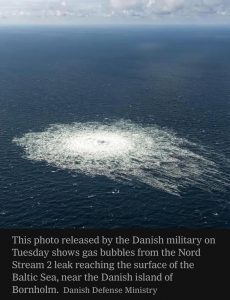
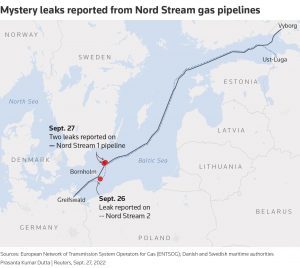
Here are some key points, both strategic and tactical, to remember as you evaluate the news.
1. The leaks are near the Danish island of Bornholm, at 54.8762°, 15.4099 ° where explosions were recorded by multiple seismic stations. The largest surface disturbance is 1km (0.6 miles) in diameter.
2. At the above location, the pipelines are in international waters at a depth of about 70 meters of water. Diving is difficult but within inspection and repair depths without the need for remote submersibles (which will also be used. It could be days or weeks before the situation is stable enough for closer investigation. Russia maintains a significant naval presence in the area.
3. In June, The CIA issued nonspecific general warnings to EU leaders over potential sabotage to pipeline and other energy infrastructure
4. While a natural accident can’t be definitively ruled out, the evidence is already strong and growing that the explosions are the result of a deliberate act.
5. All sides are speculating and pointing fingers at each other as the potential saboteurs. Without evidence, Russian media has blamed the U.S. and Ukraine. Ukraine has accused Russia of what it called a “terrorist attack.” Open speculation blaming Russia now openly exists among western analysts and commentators.
6. Nordstrom 1 has been inoperative for weeks. The Russians claiming it needed repairs and maintenance that was being delayed by sanctions and ither supply chain issues. The Nordstrom 2 pipeline has never been operational with regard to gas deliveries to Europe.
7. Western analysts have warned that Russian President Putin will attempt to manipulate gas shortages over the coming months to crack EU unity over sanctions against Russian and support for Ukraine.
8. Russia’s Gazprom operates the pipelines, but the EU has also heavily invested in the pipelines. Both sides consider themselves stakeholders and both consider the pipelines to be part of their energy infrastructure.
9. Russian media now openly calls the war a NATO war on Russia. Combined with domestic unrest in Russia, Western analysts are growing increasingly concerned that in the face of stiff Ukrainian resistance, internal resistance to mobilization within Russia, and gains made by Ukrainian forces in a recent counter-offensive that Putin make be backed into a corner and resort to the use of tactical nuclear weapons to regain control.
10. Without supporting evidence , Russian state media is now: (1) openly reporting that US helicopters were spotted “hovering” in the region of the explosions within the last several weeks, (2) asserting that only the US stands to profit from the destruction; (3) trying to suggest the explosions might be part of a US/CIA plot to fulfill President Biden’s promise in February that if Russia invaded Ukraine that Nordstrom 2 would be “stopped” (see screenshots below); (4) using US congresswoman Marjorie Taylor Greene’s tweet2 that US support of Ukraine has nothing to do with democracy and is all about gas profits.
=========
Initial Analysis:
With both Nordstrom 1 and 2 unable to deliver gas to Europe, additional strategic significance and additional vulnerabilities are now placed on overland supplies and pipelines routed through Ukraine. Russian is already threatening actions to sanction the Ukrainian operators and possibly limit or shut down supplies via these pipelines. This gives Putin any easily way to manipulate gas supplies and Use it as a strategic weapon to split the West.
There is no doubt that Russia will also accuse the US of being behind the explosions2 and also try to use this accusation to fracture NATO and US-EU cohesion. That’s the additional hidden Russian motive to blow up the pipeline.
Footnotes:
(1)

(2) RT screenshot Sept 28, 2022
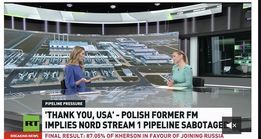
Relevant background reading:
Simulation and assessment of underwater gas release and dispersion from subsea gas pipelines leak. https://www.sciencedirect.com/science...
Analysis of underwater gas release and dispersion behavior to assess subsea safety risk. https://blogs.harvard.edu/kleelerner/...
Impact on water surface due to deepwater gas blowouts. https://www.sciencedirect.com/science...
September 20, 2022
Honor due: Queen Elizabeth II

August 19, 2022
Who speaks for Earth? Renewable energy also carries costs and perils
 A photo of a lone windmill on a ranch near San Saba, Texas in the Hill Country contrasted with a photo of a wind farm atop a west Texas mesa.I am all for developing renewable, and happy Texas is formed its own independent grid (with the bumps and bruises along the way appropriately noted), but there will be costs and choices to made with regard to our environment as we transition to a cleaner economy over coming decades, including our aesthetic environment.Just as cities are burying power cables and other transmission lines underground, are we creating a new forms of visual pollution along our shores and across our rural landscapes?How can we mitigate this loss and preserve the essence of our landscapes from shorelines to Western canyons, basins, and ranges?This is not a new problem, developers have blighted seashores for decades, and dams and power lines already carry electricity across our countryside. Still the preservation of landscapes os not something we should simply sweep aside in our quest for a cleaner “greener” economy. There’s a place and need for aesthetics in engineering.Emerging beamed energy technologies may eventually help preserve landscapes, but even with green energy we will always be forced to consider the environmental impact related to gathering, transmission, and distribution, of energy.We can develop better, with a higher regard for aesthetics than in the past. Europe has faced this issue far longer (and usually with more sensitivity) with regard to preserving visual aesthetics. Our shoreline and Western landscapes are an essential American treasure. They deserve a voice to speak for them.As always, who speaks for Earth?
A photo of a lone windmill on a ranch near San Saba, Texas in the Hill Country contrasted with a photo of a wind farm atop a west Texas mesa.I am all for developing renewable, and happy Texas is formed its own independent grid (with the bumps and bruises along the way appropriately noted), but there will be costs and choices to made with regard to our environment as we transition to a cleaner economy over coming decades, including our aesthetic environment.Just as cities are burying power cables and other transmission lines underground, are we creating a new forms of visual pollution along our shores and across our rural landscapes?How can we mitigate this loss and preserve the essence of our landscapes from shorelines to Western canyons, basins, and ranges?This is not a new problem, developers have blighted seashores for decades, and dams and power lines already carry electricity across our countryside. Still the preservation of landscapes os not something we should simply sweep aside in our quest for a cleaner “greener” economy. There’s a place and need for aesthetics in engineering.Emerging beamed energy technologies may eventually help preserve landscapes, but even with green energy we will always be forced to consider the environmental impact related to gathering, transmission, and distribution, of energy.We can develop better, with a higher regard for aesthetics than in the past. Europe has faced this issue far longer (and usually with more sensitivity) with regard to preserving visual aesthetics. Our shoreline and Western landscapes are an essential American treasure. They deserve a voice to speak for them.As always, who speaks for Earth?
August 9, 2022
Zaporizhzhia nuclear plant perils part of novel challenges regarding nuclear safety
Zaporizhzhia nuclear plant perils part of novel challenges regarding nuclear safety
Lerner, K. Lee. Taking Bearings. August 9, 2022. DOI: 10.13140/RG.2.2.12852.12168
The Russian invasion of Ukraine has posed novel problems related to nuclear safety for the International Atomic Energy Agency (IAEA), Western intelligence communities, and media outlets because this is the first time a large scale shooting war has threatened multiple nuclear power plants. Early concerns about perils posed by radioactive materials stored at the damaged and decommissioned Chernobyl nuclear power plant have now turned to fears about evident damage to the Zaporizhzhia (also spelled Zaporizhia) nuclear plant located on the Dnipro river-fed Kakhovka reservoir in a southern area of Ukraine now occupied by Russian forces.
The challenges include sifting sources for misinformation and disinformation.
Petro Kotin, chief of the energy consortium NNEGC Eneroatoam that runs the Zaporizhzhia told Reuters last week that Russian shelling had damaged three lines power lines connecting the plant to the Ukrainian electrical grid. Kotin further speculated that Russia was attempting to sever the plant’s connections to the Ukrainian grid prior in order to potentially connect it to the Russian electrical grid before winter. Prior to the Russian invasion, the Zaporizhzhia nuclear plant provided about 20 percent of Ukraine’s electrical needs.
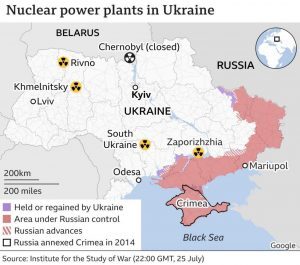 Ukraine and Russia have previously accused each other of shelling the nuclear plant site, the largest in Europe, containing six operational reactors. Three of the six reactors are still producing power. The others have been shut down to maintenance modes the Russian invasion. The plant is still operated by its Ukrainian staff subject to Russian control.
Ukraine and Russia have previously accused each other of shelling the nuclear plant site, the largest in Europe, containing six operational reactors. Three of the six reactors are still producing power. The others have been shut down to maintenance modes the Russian invasion. The plant is still operated by its Ukrainian staff subject to Russian control.
Bellingcat, a Netherlands-based investigative journalism group that specializes in open-source intelligence released geolocated drone video footage released on August 5th showed that shells had hit near cooling ponds and concrete containment facilities for 174 casks of spent uranium fuel that remain highly radioactive. While the reactor building is reinforced with steel sufficient to withstand an airliner crash, the cooling pools and dry storage facilities are not as hardened. Neither may be able to withstand explosive munitions impacts, and so a direct or close hit could scatter radioactive debris around the plant. Such damage would make operations and needed renovations extremely difficult and hazardous. Such damage could also produce a radioactive plume of dust that would rise into the atmosphere. The radioactive dust would be at the mercy of weather patterns and rainfall as to where it eventually settles. Depending on the winds, contaminated areas could reach into Russia and other countries surrounding Ukraine.
There is sufficient radioactive material at Zaporizhzhia that even if only a small percentage of radioactive material escaped into the atmosphere, subsequent rainfall could render hundreds of square kilometers uninhabitable for decades.
Russia claims both prior and recent shelling was done by Ukrainian forces using Western-supplied munitions. In June, Russia invited IAEA inspectors to view the damage and the precautions Russian forces were taking to guard the facility.
Kotin also said that according to Eneroatoam inspection records, the Soviet-era plant needs urgent maintenance and renovations. He called for IAEA inspections but said that Ukraine could not guarantee the safety of inspectors because the facility is currently occupied by Russian troops with heavy vehicles.
IAEA head, Rafael Grossi, also told the Associated Press that the Zaporizhzhia plant was in need of inspection and repairs. Fearing an IAEA visit would legitimize Russia’s control of the place, Ukraine’s state nuclear company had previously declined to invite IAEA inspectors. Grossi says that Russia, Ukraine, and the UN would all need to sign off on inspections as well as offer guarantees of safety to inspectors.
Even without the dangers of shelling, any interruption of electrical power to the plant also poses a hazard to reactors, including the still-hot shut down reactors if the interruption damages Zaporizhzhia cooling equipment or drains the system’s generators and battery reserves. Without constant cooling, even spent fuel rods in cooling pools, can boil off water, overheat and then ignite the rod’s metal cladding. Even shutting the reactors down offers little immediate protection because it can take at least five years before they can be allowed to cool down inside shielded containers. Zaporizhzhia also houses such spent-fuel ventilated dry storage casks manufactured by Sierra Nuclear Corporation (SNC).
The Zaporizhzhya Nuclear Power Plant remains one of one of the four operating NPPs in the country and can generate up to 42 billion kWh of electricity. The plant, originally designed by the Russian AtomEnergoproekt, consists of five pressurized water reactor (PWR) units, built and made operational between 1984 and 1989. The 6th unit was commissioned in 1990. Each of the six units consists of a VVER-1000/V-320 reactor that drives a 1.0 MW steam turbine. The first five units were built and made operational between 1984 and 1989. Following a building moratorium in the wake the Chernobyl nuclear disaster, and the turmoil surrounding the fall of the Soviet Union, the sixth reactor was connected to the newly independent Ukrainian grid in 1995.
Some of the Soviet PWR reactor units are past or near their originally designed 30-year lifespan. After the 2011 Fukushima-Daiichi nuclear disaster, however, Units 1 and 2 underwent lifetime extension upgrades to control, monitoring and fire suppression systems. The plant can provide remote monitoring of conditions within the reactors, turbines, spent nuclear fuel cooling facilities, and the on-site radioactive waste treatment complex.
Prior to Russia’s occupation and annexation of Crimea, a Russian nuclear fuel company (TVE) supplied the plant with enriched uranium fuel. After 2104, Ukraine’ Energoatom negotiated a contract with Westinghouse Electric Company (WEC)for enriched fuel. As part of safety upgrades, WEC has also installed passive hydrogen control systems on reactor units 1 and 2.
Without IAEA inspections assessing the condition of the Zaporizhzhia plant is difficult because both Russia and Ukraine use propaganda and disinformation as an integrated part of their respective war efforts.
The U.S.-based Institute for the Study of War (ISW) concluded that Ukrainian reports that Russian forces had mined and threatened to destroy the Zaporizhzhia plant were “likely false.” On August 8, Ukraine’s Energoatom posted statements and screenshots on Telegram taken from the Russian Vkontakte social media group (operated by Russian outlet Lenta Novosti Zaporizhia) allegedly quoting a Russian major-general vowing that the Zaporizhzhia plant would either be “either Russian land or a scorched desert.” The posts also claimed that Russian Major General Valery Vasilev, identified as head of the Zaporizhzhia occupation garrison, claimed that the plant had been mined by Russian forces. Both the Russian Ministry of Defense and Vkontakte claim Ukraine’s posts were fake.
The ISW concluded, “Regardless of the origin (or existence) of the original post, the reporting is unreliable. It is indirect and does not claim to cite an official statement or a statement made on any official Russian news or government website.”
Other Russian officials on state–controlled media have, however, previously contributed to nuclear tensions by hinting at the possibility of deliberate damage and/or destruction to nuclear plants and even atomic weapons use that Russian President Vladimir Putin has openly said “should never be unleashed” because such conflicts leave “no winners.”
July 15, 2022
Wikipedia Remains the Wild West
WASHINGTON — It’s been an interesting week to start dealing with clients interested in recommendations for texts and library resources. The question I most encountered this week was, “When budgets are tight, why pay for information available for free on Wikipedia?
I answer as follows: (1) Wikipedia is unreliable; (2) Wikipedia articles are often written, edited, and manipulated by those with vested commercial and/or ideological conflicts; and (3) Wikipedia articles are spotty with regard to being vetted or curated by subject matter experts.
For amusement and illustration, I keep my own list of 50 plus significant errors in Wikipedia entries dealing with basic science concepts (e.g., electromagnetic) and science-related issues (e.g., vaccine trials, microchip security, etc.) that have errant factual assertions that have been corrected by other (I personally avoid editing wars) but then reverted back to an incorrect answer by anonymous Wikipedia editors with more power over the entry. The examples are not controversial or close calls.
I have never accepted student citations to Wikipedia, nor have I ever allowed authors writing for me to cite Wikipedia as a source.
Sure, everyone uses Wikipedia, at least for a quick check to see what the unwashed think is important (or conversely what they are missing), but entries are now authoritative and ow need screened with the same skepticism applied to partisan news sources.
Moreover, Wikipedia is filled with plagiarism. I know because a good bit of my own writing is plagiarized there.
The most dangerous thing about Wikipedia is, however, not the howlers regarding science that anyone with reasonable training in any science discipline can spot, but the more subtle and inaccessible errors, errors that range beyond the detection of the well-educated and which can even fool all but experts in the field.
Having one of the most accessed Academia sites (harvard.academia.edu/KLeeLerner) means that I receive about a half-dozen letters a week from zealots promoting their crackpot theories everything from advanced mathematics to their own particular applications of special relativity theory. These letters are easy to spot. Most have two things in common: (1) Many of these letters begin with a pronouncement (e.g., “Newton was wrong and “I have invented the true calculus,” or “Everything you thought you knew about thermodynamics is wrong;” and (2) some assertion that contradicts (without any evidence) a well-tested theory (e.g., violates fundamental laws of thermodynamics, biophysics, molecular biology, etc.)
Almost inevitably, as I fact-check, I find that these same deranged fools have inserted their usually byzantine ideas into Wikipedia articles– often deep in the body of an article –and then cited themselves. The danger here isn’t that this is going to cost a high schooler a few SAT points or a grade on an AP test, but rather that the errors can mislead graduate students and experts checking something slightly out of field or investors trying to calculate risk. When this happens the same errors — I am sure to the delight of those who first post errant misinformation and to the utter satisfaction of those (including intelligence agencies) deliberately posting misinformation — begins to propagate across multiple articles.
There is simply no real accountability for Wikipedia. Some articles are excellent, and many authors and editors may be sincere, but any medium that relies on crowd-sources entries and editing in an age of anonymous trolls, twits on Twitter, greenwashing, corporate and intelligence manipulation of social media and search results, and a general unaccountability for Internet postings is going to be as unreliable as the quality of whiskey in a wild west saloon.
July 4, 2022
Happy Independence Day: In the land of the free, we still must choose to be free
Fairhope, Alabama — I am blessed to have Bella docked just down the bluff. If I am sitting in my study contemplating the cosmos, it takes just 10 minutes to drive down the hill, park right to Bella (no mooring balls or harbor master needed), jump aboard, fire up Bella’s inboard, set lights and radios, cast off lines, navigate the channel, and cut the engine, and start hoisting sails. I’ve rushed and made it in less time.
Tonight’s 2022 fireworks display was cancelled due to threatening weather until just 15 minutes before scheduled showtime. When the weather cleared and the show become a “go,” I still had time to make a last-minute decision to go out to enjoy the show on Bella.
Firework displays are plentiful around Mobile Bay and so bursts of light play out across the horizon. Fairhope fires its display from a pier and the shells may literally burst above the boat so that ash rains down\
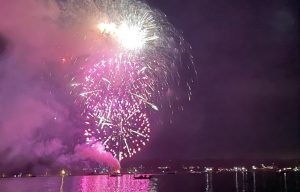 It’s also spectacular because our little town puts on a big city show. The quality of the fireworks display is second only to the every-changing flower displays about town in determining the success of a mayor’s term in office.
It’s also spectacular because our little town puts on a big city show. The quality of the fireworks display is second only to the every-changing flower displays about town in determining the success of a mayor’s term in office.
We have none of the deep problems that plague urbanity, and we are rural enough to enjoy fresh locally grown food and seafood (especially crab and shrimp) harvested and sold by local fleets.
People don’t lock their doors, crime is nearly non-existent, the polo fields are green and lush, and the children are all above average (well, at least all the children in the local International Baccalaureate (IB) program.
People are exceptionally polite. This is partly due to culture and partly due to the fact that people are well armed. We have only peaceful protests. Any mob would be quickly dispatched by citizens used to keeping the peace after storms We fund our police here and are quick to help them. People are respectful and appreciative of their first responders. They are fellow citizens and treat others as such.
Children and teens still say. “Yes, Sir” and “No Ma’am” to strangers.
The women can be spectacular. They hold leadership positions (the last two mayors have been women) and minorities — found in all socio-economic classes — are fully integrated into the fabric of the culture and community. It’s not perfect, of course. There’s still work to do, but our minorities are cherished as part of our gumbo culture.
Art and music play an important part of that culture. Well know authors and other artists abound. We also nurture local artists. On the 4th, for example, the town hosts our local Baldwin Pops orchestra, set up on the bluff to play the 1812 Overture (sorry, no virtue signaling at the expense of Tchaikovsky here).
Today’s tropical weather is an exception to our normally spectacular weather. Except for August, or when tropical systems threaten, the weather is fine for year-round sailing and for walking on long sugar-white sand beaches. If you know where to go, those beaches and dunes are also deserted. I can talk walks on the beach and not see another soul. We have four seasons if you squint a bit at what we call winter. The air and water circulation patterns keep us substantially cooler and less humid than other places on the Gulf Coast (and much cooler and drier than New Orleans). We get a couple weeks where flowers must be protected from frost and freezes, and we get the occasional dusting of snow.
Hurricanes? We endure, and then clean up and carry on. They can be both destructive and function to strengthen community cohesion. We take care of ourselves, but also look out for our neighbors.
Frequently named as one of the South’s best places to live, our only challenge is growth. We have mini-rush hour now where rural roads can get crowded. Parking downtown (no meters of course) can get sparse at times.
This is not an accident. People must choose to live free. They can choose to see America is a glass half full and filling or they can be destructive and divisive to themselves and others by dwelling on America’s flaws and scars.
Fairhope is in a deeply red state and county, but the town is an artist refuge and writer’s community known for being purple. A former New York Times editor-in-chief lives here. Fairhope has even voted for a Democrat in a recent senatorial election.
Like undisciplined children. people can whine about their rights, or perceived entitlements, or they can roll up their sleeves and pitch in to construct instead of merely deconstruct society.
Why do people choose to live in crowed places, live in places hostile to freedom, live without individual capacity, and responsibility, live where places where anger is a persistent form of impotent virtue signaling, or live where they are manifestly neither safe nor able to protect their families and interests?
I have traveled the world several times over and I have lived in wonderful cities like Boston and Paris, and yet the answer to my question eludes me.
Yes, I know the standard answers. Education, work, opportunities. All of that is fair, and a part of life. People don’t always end up in their ideal spot. Ultimately, however, we must choose where and how we want to live.
I am thankful life led me here and that I made good decisions about where to raise a family so that they might enjoy all the richness of life.
May God bless our men and women who guard American freedoms, and may God bless those who work to make America a more perfect union striving to secure the blessings of liberty to ourselves and our posterity!
[Author’s note. With a good bit of the local fleet of sailboats and powerboats out on the water — some anchored, some maneuvering about — it was too dangerous to turn my attention away from the helm to film this year. Accordingly, I am posting a clip from last year.]
June 28, 2022
U.S. Border Policies: It’s not just political power that’s at stake, it’s human lives.
June 26, 2022
Honor Due: Craig Lanier Allen (1967-2022)
June 25, 2022
What does the data tell us about the “good guy with a gun stopping a bad guy with a gun” scenario
I watched an interview of Adam Lankford, a professor of Criminology at the University of Alabama, on CNN this morning. It was obvious that the interviewer’s intent was to offer up Lankford’s research as an effort to debunk — or at least cast doubt – on the “good guy with a gun stopping a bad guy with a gun” argument offered by many seeking to limit or defeat control measures.
In this post, I am not addressing the larger issue regarding the validity of offering the intuitive argument that “good guy with a gun is the best way to stop a bad guy with a gun,” nor am I dismissing the perils of people untrained with weapons attempting to make decisions and use weapons during a crisis situation.
I am limiting my comments here to the perils of citing Lankford’s data or accepting the arguments Langford made based on his data.
Lankford offers conclusions beyond his data and does not apply proper context or controls for his data At best, it is interesting but tepid scholarship. Lankford argues his data shows that the “good guy with a gun stopping a bad guy with a gun” scenario only happens in about 3 percent of mass shooting events because of the rapidity of such events (i.e., they are over before anyone can act). That’s true — most shooting events are over before anyone –citizens or police – can react. But to offer that data as some sort of argument against the “good guy with a gun” argument is faulty.
People carry weapons primarily for personal defense and Langford’s data does nothing to address that motivation to carry a weapon. Nor does Langford’s data treat the “good guy with a gun” capacity to personally deterring or stop an incident personal to the carrier, their family, etc. in incidents more intimate and below the threshold of a mass shooting.
While many would be willing to help stop a shooter, as above, the circumstances where this opportunity presents itself are exceedingly rare. However, the “good guy with a gun stopping a bad guy with a gun” also has a meta “deterrence” component, and Lankford’s data fails to test for the hypothesis that when potential perpetrators know that a substantial number of people are armed, they are less likely to attack such populations and to seek out softer targets.
Moreover, Lankford does not evaluate whether armed civilians were in a position to stop mass shooter. In a sloppy bit of reasoning during a CNN interview. Lankford simply cited the fact that America has a high number of guns relative to other countries. While that is certainly true and may be relevant to other facets of arguments surrounding gun control, it says nothing about the context of the mass shootings evaluated by Lankford with regard to whether there were armed citizens in a position to stop the shooting.



